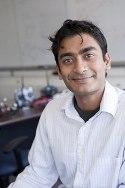event
Robotics and Intelligent Machines Center (RIM) Seminar-Ashutosh Saxena
Primary tabs
Unless otherwise noted, all seminars are held in room 1116 in the Marcus Nanotechnology Building from 12-1 p.m. Seminars are open to the public.
Ashutosh Saxena, Assistant Professor, Microsoft Faculty Fellow, and Alfred P. Sloan Research Fellow in the Department of Computer Science at Cornell University, presents How Should a Robot Perceive the World?
Abstract
In order for a robot to perform tasks in the human environments, it first needs to figure out "what" to perceive. While for some robotic tasks (such as an object finding robot) this is relatively straightforward (e.g., infer the object labels from RGB-D data), many other robotic tasks require a robot to be more creative about what to perceive. For example, for a robot to arrange a disorganized room, it would need to perceive the human preferences about the usage of objects as well as the low-level manipulation strategies. In this talk, I will illustrate the issues surrounding "what to perceive" through a few examples.
The key to figuring out "how" to perceive lies in being able to model the underlying "structure" in the problem. I propose that for reasoning about the human environments, it is the humans that are the true underlying structure in the problem. This is not only true for tasks that involve humans explicitly (such as human activity detection), but also true for tasks in which a human was never observed! In this talk, I will present learning algorithms that model such underlying structure in the problem.
Finally, using such learned structure, I will present several robotic applications ranging from single-image based aerial vehicle navigation to personal robots performing tasks of unloading items from a dishwasher, loading a fridge, arranging a disorganized room, and performing assistive tasks in response to human activities.
Bio
Ashutosh Saxena is an assistant professor in computer science department at Cornell University. His research interests include machine learning and robotics perception, especially in the domain of personal robotics. He received his MS in 2006 and PhD in 2009 from Stanford University, and his BTech in 2004 from Indian Institute of Technology (IIT), Kanpur. He was a recipient of the National Talent Scholar award in India and the Google Faculty award in 2011. He was also named a Alfred P. Sloan Research Fellow in 2011, and a Microsoft Faculty Fellow in 2012.
Saxena has developed Make3D (http://make3d.cs.cornell.edu), an algorithm that converts a single photograph into a 3D model. Tens of thousands of users used this technology to convert their pictures to 3D. He has also developed algorithms that enable robots (such as STAIR, POLAR (http://pr.cs.cornell.edu) to perform household chores such as unload items from a dishwasher, place items in a fridge, etc. His work has received substantial amount of attention in popular press, including the front-page of The New York Times, BBC, ABC, New Scientist, Discovery Science, and Wired Magazine. He has won best paper awards in 3DRR and IEEE ACE, and he was named a co-chair of the IEEE technical committee on robot learning.
Groups
Status
- Workflow Status:Published
- Created By:Josie Giles
- Created:08/12/2012
- Modified By:Fletcher Moore
- Modified:10/07/2016
Categories

